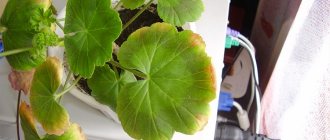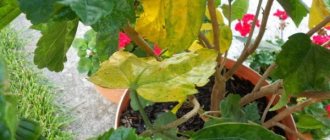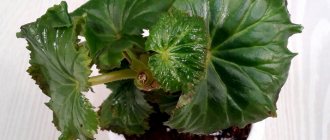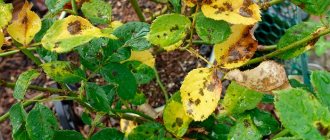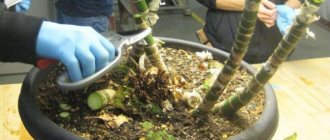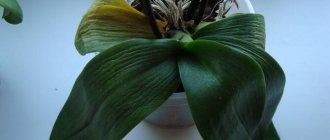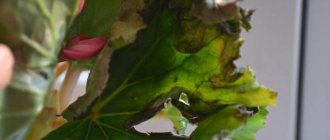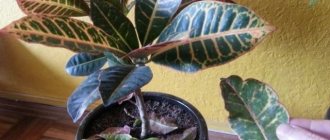Pests
Sometimes the leaves of indoor roses slightly change color to a lighter shade, which many confuse with yellowness.
At the same time, the old leaf plates begin to wither, and the young ones grow deformed and pale. This indicates the presence of pests in the root system area. Carefully move the soil away from the base of the trunk and a little deeper. This is where harmful larvae or worms live. Some sources recommend catching parasites with tweezers. Give it a try. And it’s good if there was only one worm. What if the soil was more contaminated? Are you going to use tweezers all over the pot? During this time, the indoor rose will simply bend.
Don't rely on your sleight of hand, it may not be enough. Use any broad-spectrum or long-lasting systemic insecticide. Be sure to repeat the soil treatment in a month.
Advice. Be sure to replant your indoor rose from store-bought soil into your own. But only after disinfection by freezing or heating in the oven.
Dangerous pests
Aphids, thrips and spider mites are the most common pests of house plants, due to which they often get sick and dry out. They are easy to spot. Usually both the insects themselves and traces of their activity are visible. The presence of parasites is indicated by gnawed areas of indoor rose leaves and small dark spots on them. The presence of a tick will be revealed by a spider web, which is usually located under the foliage. If such signs are found, it means that the flowers wither for this very reason.
All affected parts of the plant are carefully removed. Then treatment is carried out with special solutions against insects.
It is recommended to do this as a preventive measure in the summer, even if the pests are not visible.
Causes of yellowing leaves of indoor roses
The reasons for yellowing of leaves can be very diverse, for example, sunburn. The fact is that direct sunlight is destructive, not only for the leaves of an indoor rose, but also for its flowers. It is best to keep this plant near windows that are directed to the southwest or southeast.
But there are several other possible reasons why the leaves of an indoor rose begin to turn yellow:
- watering the plant with too cold water;
- overdried substrate;
- draft;
- overflow
For normal functioning, indoor roses simply need fresh air. In this regard, in the summer it is best to keep it either on the balcony or on the terrace. You can also take a flowerpot with a rose to a flowerbed and bury it a little in the ground. If you live in an apartment and you don’t have this opportunity, you can keep the rose just next to an open window, while avoiding drafts. Thanks to such manipulations, an indoor rose can easily withstand even the strongest sun.
We present to your attention several possible reasons for the change in leaf color of indoor roses:
- if your indoor beauty does not have any pests and is not sick with anything, but its leaves still turn yellow, this may indicate that the plant lacks some nutrients;
- if the leaves of an indoor rose become pale green and turn yellow from the midrib, this directly indicates a lack of nitrogen;
- yellowed leaves with spots are evidence of potassium deficiency. And if yellowing is visible between the veins of the foliage, it means the plant lacks iron;
- Interestingly, rose leaves can turn yellow even if the plant receives too many nutrients. In order to prevent this, it is necessary to adhere to the correct dosage of fertilizer, which is indicated on the package;
- The plant should be fertilized on time, especially during the flowering period. The fact is that at this time the rose is greatly depleted and requires additional nutrition. If this is not done, the leaves of the plant will be yellow and limp, and the number of flowers will be insufficient;
- Another cause of yellow leaves may be chlorosis. The main signs of its presence are yellowing of the leaves, but with green veins, as well as yellow spots on green leaves. In order to combat this disease, as well as to prevent the disease, you should use a water-soluble iron chelate fertilizer. They need to not only water the plant, but also spray it.
Remember that another reason for yellowing of the leaves of an indoor rose may be its improper replanting. This plant must be replanted once a year, preferably in February
This is done by transshipment, but with extreme caution so as not to damage the roots of the plant in any way. An already transplanted plant should be moved to a warmer place.
By the way, when replanting a plant, it is necessary to change not only the soil, but also the pot. Every year its diameter should increase by 2-3 centimeters.
Preventive measures
To ensure that the leaves of the Chinese rose always remain green and healthy, the following conditions are observed:
- water not too often, but regularly, do not allow the soil to dry out;
- do not leave in direct sunlight, but put it in partial shade;
- feed once a week until September, and then once a month;
- water less frequently in autumn and winter, keep indoors at a temperature not lower than +15°C;
- sprayed with water every day all year round;
- transplanted in time into suitable soil with drainage;
- To prevent indoor plants from getting sunburn, place them in the sun for a short time and gradually increase their exposure;
- regularly inspected to identify pests;
- Regularly clean the area from dust using a warm shower, covering the ground.
To learn why the Chinese rose drops its buds, watch the following video.
Diseases that cause yellowing of roses
One of the common diseases of indoor roses is powdery mildew. Leaves, stems and buds are affected by fungi. First, a light fluffy coating appears, then it begins to darken, and brown spots form. The leaves turn yellow, become deformed, and curl. If you do not immediately react and treat the plant, it will die. At best, its growth will stop, the foliage will fall off, and the flowers will lose their petals. The rose will lose its attractive appearance.
All affected parts of the plant will have to be removed, otherwise it will not be possible to defeat the disease. It spreads rapidly and also easily spreads to neighboring flowers. Spores are carried on the hands after working with an injured representative of the flora, and easily move through the air.
Note! At the early stage of the disease, when the leaves seem to be sprinkled with flour, and the plaque is wiped off with your fingers, you can use a solution of soda with added soap. If the plant does not recover, it is better to resort to fungicides
Black spots may appear on the leaves of indoor roses. They have jagged edges and are clearly visible. At the same time, the leaf blades themselves turn pale, turn yellow, and wither. Over time, the spots grow and merge, and may appear on shoots. Plant growth slows down and flowering does not occur. The affected leaves fall off, new shoots are formed, which do not have time to gain strength and immediately encounter the disease. A systemic fungicide will help cope with it. The substance penetrates the plant and promotes its recovery.
If yellow-red spots are noticeable on the rose, then rust has appeared. The main reasons are high temperature at home and stale air when the room is rarely ventilated.
Rust appears due to stuffiness
Harvesting cuttings
The cut should be of medium thickness and developed. A 2-3 year old plant with a thick central part will take a long time to adapt and may begin to rot when moved outside. Young ones, usually red, are also discarded due to slow rooting. They do not have time to fully develop before the onset of cold weather and freeze in winter.
Typically, 3 types of cuttings are suitable for propagation:
- Stems are the most common planting material.
- Single lignified cuttings are fairly mature and low-growing annuals with a diameter of 0.4-0.5 cm. They are usually rooted in the spring.
- Semi-woody - cuttings are harvested in the summer, using the middle part of the shoot.
If there are varieties or single bushes on the site, you can try cutting off shoots with one bud. However, remember that they can produce weak plants that are not ready for winter. It is best to use 2-3 internodes, but for yellow roses 4 or more internodes are better.
Here are the basic steps for preparing a seedling:
- The length of the shoot should be at least 10-18 cm.
- The top cut is a straight cut made at a right angle, offset 0.5-2 cm from the sheet.
- The same distance is measured from the bottom of the bud, but the cut should be made at an angle of 45 degrees, using a sharp, disinfected knife.
- Remove thorns and lower leaf blades. Cut the top ones in half lengthwise. This will help retain moisture inside the seedling.
Prepared cuttings should be placed in water, to which rooting agents, for example, heteroauxin, can be added. A honey solution is used for the same purpose: take 1 tablespoon of honey and a few crushed rose leaves, 1 tablespoon each. The liquid should be changed every 2 days, and after 15-20 days a light-colored thickening - callus - will appear on the lower section.
Then the seedlings can be planted in the garden or wait until long roots develop.
The disadvantage of this method is the lack of oxygen for proper development in the aquatic environment and the resulting rotting.
In regions with cold winters, bushes grown from cuttings wait out frosts in a dry basement with good ventilation, buried at an angle in the sand. Optimal storage temperature is +1…+3 °C and humidity 65-70%. Next season, young bushes remain outside for the winter.
Improper watering
If you water your flowers incorrectly, you can seriously harm them. Cold water should not be used to water roses. As a result, the bush becomes sick, stops growing and dies over time. The water should be soft and settled. Some gardeners advise boiling it.
The frequency of watering can be selected according to the condition of the soil in the pot. If its top layer begins to crack, moisturizing is necessary. Mature plants are watered two or three times a week. In the summer heat, you can water them more often and install a humidifier in the room.
The foliage of indoor roses often turns yellow due to improper watering of the plant. This can be either overwatering or insufficient watering. Overdrying of the flower, in addition to its yellowing and loss of leaves, may also be indicated by a general depressed appearance and the appearance of cracks in the soil. If overwatering occurs, the symptoms will be somewhat different: yellowing of the foliage in this case is accompanied by lethargy of the plant, its wilting, and the presence of a “swamp” in the pot.
Aftercare
In order for a flower to delight its owners with green foliage throughout the year, it is imperative to properly care for it. The microclimate indicators of the room where the plant is located must be within a certain range.
One of these important indicators is temperature. The plant grows quite well if in summer the room where it is located is maintained at a temperature of +21 to +24 degrees. Minor changes in the temperature regime do not have a significant negative impact on the life processes of the plant. However, experts advise not to allow the temperature in the room where this plant is located to drop below +12 degrees during the winter season. Otherwise, the flower may simply freeze and get sick.
Humidity is another important indicator that chlorophytum lovers are recommended to monitor. While the plant is actively growing, it is desirable that this microclimate indicator be 70–75%.
It is recommended to maintain this humidity during the warm season. In winter, it is enough for this figure to be about 50%.
House plant lovers quite often ask botanical experts whether chlorophytum needs any feeding. Experts note that in some cases, for example, when the color of leaves changes or when growth is poor, special combined products can be used to improve the functioning of plants. You shouldn't do this too often. As a rule, complex fertilizing to improve the growth of chlorophytum can be used 1–2 times a month.
Liquid complex products for decorative indoor plants or preparations intended for flowering plants are suitable for flowers.
Chlorophytum is a plant with abundant foliage. To keep the leaves elastic and brightly colored, they need enough moisture.
Regular watering is an important component of proper care of this plant.
During active growing season, experts recommend watering this flower 2-3 times a week. At the same time, the flower does not require too much moisture, as this can lead to damage to its root apparatus.
Chlorophytum is a flower that “loves” to be in fairly well-lit places, but the light should be diffused. Active and even excessive insolation can lead to damage to the delicate leaves of the plant. It is recommended to place this flower in rooms with windows facing south, southeast and southwest
It is important to monitor the condition of the flower. If the insolation during the day is too intense, then in this case it is better to move the plant to a less lit place in the afternoon
Why do rose leaves turn yellow?
Most often, yellowing of foliage is caused by the following reasons:
- Lack of mineral fertilizers. Depending on what the plant lacks, it turns yellow in different ways. When a crop needs nitrogen feeding, it turns yellow completely, starting from the lower leaves. Application of universal fertilizers or urea can help. If a rose lacks iron, it begins to turn yellow in spots - from top to bottom. In this case, any acidifying fertilizer will do.
- Excess feeding. Excess mineral fertilizers can also lead to leaf fall. When the flower is weakened and you want to feed it, it is better to start with half the dose, otherwise you can burn the roots.
- Pests and diseases. One of the most common diseases is chlorosis. You can fight it with the help of Antichlorosin, which dissolves well in water. The plant is watered with it twice during the growth period, and then once every two weeks, if necessary.
- Excessive humidity. Although roses love moisture, excess is harmful to it, otherwise it will begin not only to turn yellow, but also to rot. Finding a middle ground is not difficult - it is enough to provide good drainage and water the plant as soon as the top layer begins to dry out. In addition, it is useful to spray it with warm water from a spray bottle.
What to do if your houseplant drops its leaves?
There are several reasons why this whimsical plant sheds its leaves and dries up:
- Physiological aging is when a flower, at the final stage of its life, begins to shed its leaves and buds.
- Seasonality - when an indoor flower sheds its leaves in the fall so that new ones grow in the spring.
- Violation of the light regime - lack or excess of sunlight.
- A change in weather or a change in the microclimate of the house - a change in air temperature and humidity level in the room, the appearance of a draft or the start of heating devices in the house affect the condition of the rose.
- Violation of the irrigation regime - lack or excess of moisture in the soil.
- Presence of pests – parasites dangerous to flowers, especially spider mites, can destroy a plant in a matter of days.
- Unsuitable soil - a lack or excess of nutrients in the soil leads to the fact that the flower begins to hurt and wither.
- The rose is damaged by pathogenic microflora - the flower begins to rot or black spots appear on it.
- Carefully examine the flower. If the leaves turn yellow and fall off on one side, this may indicate an excess of sunlight. In such a situation, it is necessary to provide the rose with diffused light.
- Check the soil in the pot. If the pot has cracked, dry soil, you need to start watering it regularly. For irrigation, use pre-settled water at room temperature.
- Remember the last time the soil of the rose was changed. If it was more than a year ago, then it is advisable to urgently start feeding the plant. But you should carefully study the instructions and strictly follow them so as not to overfeed.
- Check leaves and stems. If pests are detected, it is recommended not to delay the start of treatment. In this case it is necessary:
- Isolate the rose from other plants.
- Use a sterile blade to trim off all affected areas.
- Treat with parasite repellent according to instructions.
If a rose drops all its leaves in the shortest possible time in spring or summer, this means that:
- The flower is located in a room with very dry air. What to do in a situation if the plant has dropped all its leaves:
- Move it to another room or install a humidifier nearby.
- Water the flower regularly and do not allow the soil to dry out.
The flower was infected with a dangerous disease. In this situation, the action plan is as follows:
- Trim off all affected areas of the flower and remaining buds with a sterile blade.
- Treat the plant with special means.
A rose that has dropped all its leaves will take a long time to recover, so it is recommended to be patient and wait, while observing the light and watering regime.
Prevention measures
Preventative measures are very important. They help reduce the risk of various chlorophytum diseases
Lovers of indoor plants who are planning to add this plant to their collection or have it in their collection are advised to pay special attention to preventive measures
For a plant to grow well, it needs good soil. You should choose the right soil for this particular flower. When purchasing soil, it is better to give preference to a substrate that has neutral acidity. You should choose a substrate that allows water and air to pass through perfectly. To reduce the risk of various parasites appearing in the substrate, before using it for planting or replanting a plant, it is recommended to treat it
Thus, the soil can be calcined or treated in a water bath (depending on the type of soil substrate). An important preventive measure is compliance with all microclimate indicators. It is better to place the plant in a well-lit place, and also monitor the optimal temperature and humidity in the room
If for some reason the air in the room where the flower “lives” decreases, then it is recommended to think about the possibility of purchasing special home air humidifiers - humidifiers. Having such a device in a home where air humidity is reduced is a necessity, not a luxury. To keep the leaves and roots of the plant in good condition, you should not forget about regular watering. It is better to water the flower with water that has been previously settled. We should not forget about transplantation. Experts recommend carrying out this procedure only when necessary. Some (especially beginners) home plant lovers abuse replanting. This often leads to the fact that in the future the flowers begin to grow poorly due to damage to the root system. In order not to damage the plant, it should be replanted correctly - in compliance with special technology. Another important preventative measure is to conduct regular plant inspections. To do this, you need to inspect the leaves. During this “home inspection” you should pay attention to the color and elasticity of the foliage. And also, upon examination, you can notice pests and parasites on the leaves. If they were discovered, then you should not hesitate to carry out treatment. Delayed treatment can lead to the death of the flower.
How to save an indoor rose after purchase
The rose is a difficult flower to keep at home; it is quite demanding and capricious. It is not enough to become the happy owner of this beauty, you also need to preserve the flower and find an approach to it, otherwise sad consequences will not keep you waiting.
Yes exactly. The purchased plant usually looks fresh and full of vigor, blooms amazingly and it seems that it will always be like that.
In fact, the plants arrive on the counter fed with all kinds of stimulants; in addition, they have special packaging that retains high humidity. Once on our windowsill, roses are deprived of all this.
Almost immediately, inexperienced gardeners have problems: the roses begin to turn yellow, their leaves dry out and fly off, the buds fall off and turn black. Rosette orders to live long and disappears, leaving behind nothing but frustration.
It should be noted that the rose is considered an open ground plant. Some varieties are more suitable for indoor use than others. But this does not mean that keeping them in an apartment is an easy matter.
So, what steps should you take when you bring a rose home:
Remove the packaging wrapper, if any. Although the packaging helps to retain moisture, it often causes the rose to become infected with fungal diseases while still in the store, because... packaging interferes with air exchange, creating an ideal environment for fungi. Use pruning shears or scissors to remove all wilted leaves, blackened and dried stems that are on the plant. Flowers and buds also need to be trimmed. Of course, for the sake of them we buy a plant and we would like to admire them to our heart’s content, but the plant, the flowering of which was stimulated by special preparations and greenhouse care, subsequently simply cannot withstand such abundant flowering, and, having given all its strength to it, dies
Therefore, we cut off all the flowers and buds that are present on the plant, along with the supporting stem. Pay attention to the number of bushes in the pot. Growers of indoor roses often plant several plants in one pot to create the appearance of a lush flowering bush.
Crowded plants weaken each other and there is a lack of nutrients. Bushes, if there are several of them, must be planted in different pots.
After transplantation, it is necessary to treat the rose with antifungal drugs (Fitosporin) and pest control drugs (Fitoverm).
Effect of weather conditions
Sometimes all your care efforts can be ruined by unfavorable weather conditions. The leaves of the rose dry out due to too frequent rains. Indeed, in connection with this, the soil becomes waterlogged, water washes away nutrients and the plant suffers.
Temperature changes can also cause spoiled shoots. For example, after heavy rain, the bright sun does not have as good an effect on the flower as we would like. The sun begins to warm up the drops that remain on the plant, and at the same time the rays burn the leaves.
Too hot weather also leads to deterioration of the plant. It is impossible to somehow influence the weather and change it. But a good way out of this situation would be to plant in a convenient place - where the gardener can have maximum control over external factors from watering to lighting.
Caring for an indoor rose after purchase - how to preserve a flower
The indoor rose is a very delicate flower and capricious to environmental conditions, so you should take care of this beauty from the first days of its acquisition. The fact is that in flower shops, roses in pots are fed with special preparations, thanks to which they maintain their ideal appearance; in addition, the packaging of the plant helps maintain the required humidity level.
- Remove the cellophane packaging - in apartment conditions it will not maintain the required level of humidity, but will cause poor air circulation and the appearance of pathogenic bacteria and fungus;
- Cut off all non-living leaves and stems with sharp scissors; the same should be done with leaves that have defects - spots, dried tips;
- Remove flowers and growing buds, no matter how sorry it is - if you give all the emerging buds the opportunity to bloom, the rose will lose all its strength and die;
- Plant a rose if several bushes are planted in one small pot (as a rule, in stores they do this to give the flower a lush shape) - this way there will be enough nutrients in the soil for each bush;
- Treat your home rose with drugs against fungus and parasites (Fitosporin, Fitoverm).
Replanting an indoor rose after purchase is necessary if the pot is too small for it - in this case, the flower is carefully removed from the old flower garden along with the soil, the brown and black roots are removed (the healthy color of rose roots is white), rotten parts, then the plant is placed in a new pot with properly selected soil. The soil for roses can be prepared independently; for this you will need:
- Compost;
- Leaf humus;
- Soil from under coniferous trees;
- Turf soil;
- Clean sand.
The listed components are mixed in a ratio of 1:1:1:3:1, the soil mixture is poured into the flower garden on top of the drainage. The rose is placed in a new pot along with an old lump of earth, firmly fixed and watered with warm water. It is recommended to treat the newly transplanted plant with a drug to enhance immunity - Epin is ideal.
Pests and feeding
Rose, like many other indoor plants, is very afraid of spider mites. Determining the presence of such a pest is quite simple. The leaves begin to fall and small bugs can be seen climbing on them. If you turn the leaf over, you can see a characteristic white coating on its back side. To solve this problem, you need to use special preparations that are sold in flower shops. Spraying the flowerpot is carried out according to the instructions on the product packaging.
Roses are quite capricious and demanding plants. For normal flowerpot growth you will need a sufficient amount of minerals and trace elements. A lack of any element will negatively affect the plant. So, if a flower lacks magnesium, its leaves begin to fall off over time. In the case of a lack of nitrogen, they stop growing and change their color. To prevent such changes, it is necessary to feed the plant in a timely manner. To do this, it is worth using special fertilizers designed specifically for flowering flowerpots.
A common cause of discoloration and falling leaves is excessive flowering. The development of buds and flowering takes quite a lot of effort. When there is a lot of color, the leaves become defenseless and are easily susceptible to diseases, pests and various changes. This problem is solved with the help of special fertilizers and preparations that are sprayed on the flowerpot. With their help, you can strengthen the flower’s immunity and supply it with all the microelements and minerals for full growth and development. All medications must be used in accordance with the instructions.
Yellowing of roses due to lack of nutrients in the soil
The beginning of yellowing or falling leaves can be explained by a lack of useful elements in the soil. The most important substances that influence the development of culture include the following:
Iron
Why do rose leaves turn yellow outside in summer?
A deficiency of this substance provokes the development of chlorosis. With this disease, the foliage becomes yellow, decreases in size and curls.
To cope with the problem, it is worth using products such as Ferrilene, Ferovit. The ampoule of the composition must be mixed with water and sprinkled on the plants.
Nitrogen
This product is responsible for the condition of the green mass. A deficiency of the element provokes blanching of the foliage and its gradual yellowing.
Roses have a special need for the element in the spring. In this case, you need to add ammonium nitrate. It is also permissible to use a combined composition.
For reference! It is worth considering that excess nitrogen can cause fungal pathologies, which negatively affects the condition of the bushes.
Potassium
If there is a lack of this element, the edges of the leaves dry out in the plant. At the same time, the veins remain green. After a certain time, the leaf blades turn completely yellow and turn red-violet.
The rose should be fed with potassium magnesia. A large amount of potassium provokes developmental delays.
Manganese
Affected foliage acquires a yellow tint between the veins - from the edges to the central part. A green border appears around the veins. In this case, only old leaves turn yellow. The rose needs to be fertilized with manganese sulfate and the soil deoxidized. You can add peat to it. Ammonium sulfate will also work.
Magnesium
If there is not enough of this substance, dark red spots appear between the veins. The edges of the leaves remain green. At the same time, they are observed to fall off.
To avoid such problems, you need to regularly add ash to the soil. Magnesium sulfate will also work. In this case, the increased content of the substance provokes a violation of the absorption of potassium.
Insufficient application of fertilizers provokes the appearance of a yellow border on the foliage.
Detrimental factors affecting flower development
First you need to figure out why the leaves of an indoor rose turn yellow. Often, to solve this problem, it is enough to move the pot to another place where there is no direct exposure to sunlight - then the condition of the flower will normalize. But it happens that the reasons for yellowing of leaves lie in other unfavorable conditions for the development of the plant.
Unfavorable factors for roses
If you water with too cold water, you should water with water at room temperature. Drafts - it is recommended not to keep the plant under an open window. Abundant or, on the contrary, rare watering - the rose requires optimal moisture content in the soil. Lack of fresh air - in summer you need to take the pot out onto the balcony or terrace. Lack of nutrients - roses definitely require regular feeding. Incorrect replanting - if you need to move the plant into a large container, this should be done with the utmost care, and the month chosen for such actions is February. In this case, the rose has a better chance of taking root. Powdery mildew is a white coating that appears when there is excessive application of fertilizers or lack of fresh air. Rust – appears in the form of bumps
The reasons for its appearance are abundant watering and high room temperature. Thrips - appears at low humidity, it gives the leaves a gray-yellow color. Spider mites are caused by too dry air or insufficient space for plants.
Yellowness of leaves as a result of care errors
Leaves may turn yellow and fall off due to improper care. To avoid problems, it is worth monitoring temperature parameters, lighting, and watering.
Lack of lighting
The plant can hardly tolerate exposure to direct sunlight. At the same time, it feels great in the fresh air. Therefore, in June, the bush should be taken out onto the balcony or into the garden, but shaded a little.
Important! It is enough for the plant to be in a lighted place for 5 hours a day. Yellowing foliage indicates uncomfortable conditions
Wrong soil
The rose needs loose soil that allows moisture and water to pass through well.
It is important to avoid stagnation of liquid near the roots
To plant a plant, mix turf and humus in equal parts. You also need to add a little sand to the composition. A drainage layer should be placed at the bottom of the pot.
Eating disorder
The plant needs periodic fertilization. If a crop is deficient in nitrogen, its leaves turn pale and become covered with yellow streaks. Potassium deficiency also has a negative impact on the bush.
The room temperature is not suitable
When growing a crop, it is important to ensure that the rose pot does not overheat. In summer it should be taken out onto the balcony
In winter, the bush can be at room temperature.
Important! It is necessary to provide the rose with protection from the cold wind. She also does not like sudden temperature fluctuations.
Drafts have a detrimental effect on indoor plants
Rose reacts negatively to drafts, but at the same time needs fresh air. To provide the plant with comfortable conditions, it is permissible to make a paper cylinder and wrap it around the pot.
Transplanting an indoor rose
To replant a rose, remove it from the previous pot along with the earthen lump. Assess the condition of the roots entwined in the ground.
If the roots are hair-thin, brown or blackened, dry or rotten, the plant will most likely die. You can try to save it: cut cuttings and try to root them.
Healthy roots are bright white or yellowish in color and look quite dense, like a thin wire. If the roots are only partially missing, you need to remove all the rotten and damaged ones, leaving the healthy ones.
Place expanded clay or other drainage at the bottom of the new pot.
It is better to purchase a soil mixture ready for roses or a garden mixture. Do not use cheap soil; it contains a lot of peat and few nutrients. It is better to choose a higher quality soil mixture.
Fill the drainage with soil and compact it a little. Place the rose bush together with a lump of earth, cover it with new soil, periodically compacting it so that the bush does not dangle in the pot, but is well fixed. Water with settled or filtered water at room temperature.
Treatment against diseases and pests is necessary. A pruned and replanted plant is weakened and susceptible to disease, even if it was well cared for at the store and no infection occurred. Therefore, it is better to play it safe and process it.
Also, after transplantation, treatment with Epin is effective - it will strengthen the plant’s immunity and reduce stress from transplantation.
Spray your plant; it requires high humidity, especially in conditions of operating heating and dry air in the apartment. If the rose is very small and weak, then the pot can be covered with a bottle (with small holes) on top, creating a greenhouse, and only then gradually accustom the rose to apartment air.
Next, we place the pot with the transplanted plant in a well-lit place. If you have a shady side and there is not enough light in winter, illuminate the rose with fluorescent lamps.
Ways to eliminate curl
Leaf deformation usually does not occur immediately. The leaves curl gradually, so gardeners do not notice the changes immediately. Having noticed alarming signs, you need to immediately determine the cause of the twisting. The easiest way is to change the location if the rose is grown at home. A well-lit window sill on the east side of the apartment is suitable for an indoor flower. It is not advisable to place pots of roses on southern windows due to the high risk of sunburn. If there is no other option, during the hours of maximum solar activity, rose bushes are shaded with a screen or curtains.
The rose bush is provided with regular care according to the following rules:
- for indoor roses, arrange good drainage by placing a layer of pebbles, broken brick, expanded clay or other suitable material on the bottom of the pot;
- Roses are watered regularly, not allowing the soil to dry out, but also not flooding it;
- For irrigation use settled water at room temperature;
- to reduce evaporation, the top layer of soil is mulched and regularly loosened;
- If possible, organize drip irrigation.
Fertilizing is applied only during the active growing season. To develop green mass, fertilizers with a high amount of nitrogen are used twice a month. If buds form on the plant, the application of nitrogen supplements is suspended and replaced with potassium-phosphorus compounds. They contribute to the formation of large and bright flowers. In October, fertilizers are completely abandoned. From this time on, the rose gradually goes into a state of rest.
To keep the bush beautiful and unthickened, the buds are cut off as they fade. Additionally, pruning is carried out in early spring, removing all damaged and diseased shoots. Thanks to this procedure, further flowering of the plant improves.

